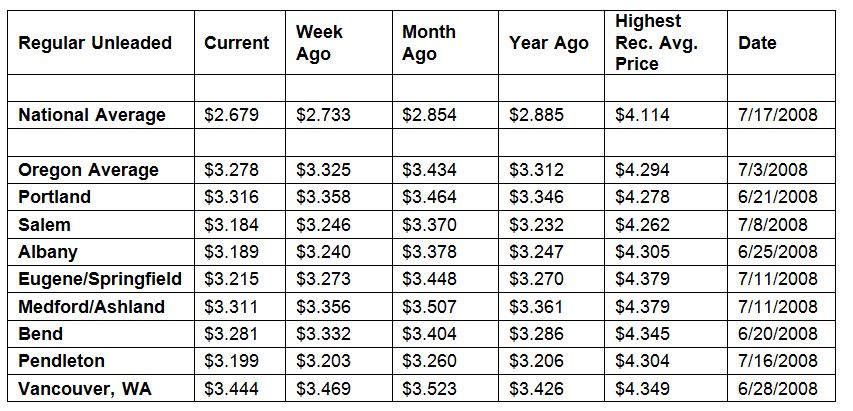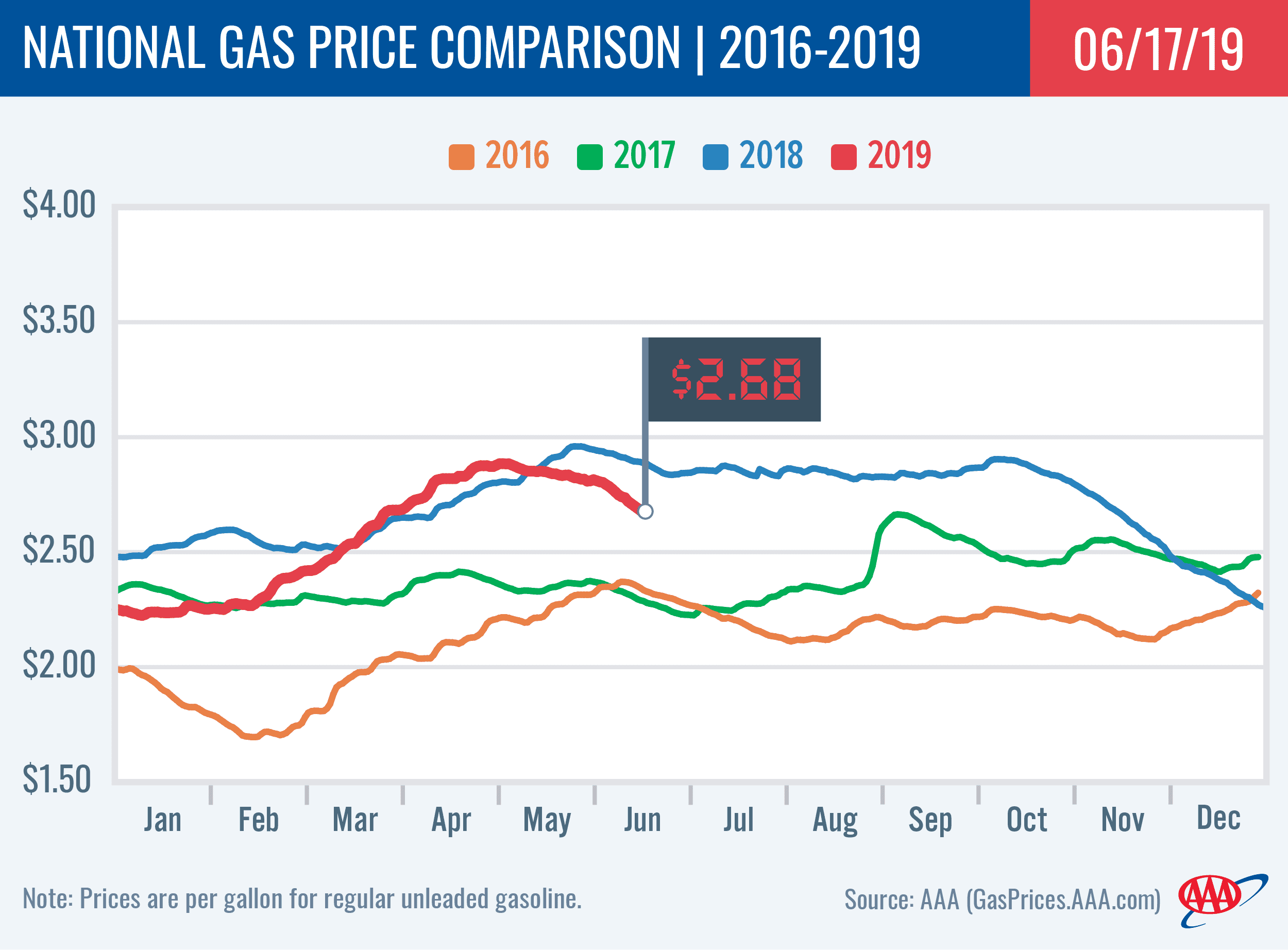PORTLAND, Ore., – Pump prices continue on the downward trend which began around Memorial Day. For the week, the national average falls a nickel to $2.68 a gallon. The Oregon average also loses a nickel to $3.28 a gallon.
“Growing inventories of gasoline in the U.S. are putting downward pressure on pump prices as we head into summer,” says Marie Dodds, public affairs director for AAA Oregon/Idaho.
The latest Energy Information Administration (EIA) report shows that total domestic gasoline inventories jumped a million bbl last week to nearly 235 million bbl., despite strong demand. The EIA says gasoline demand reached 9.877 million b/d last week – the sixth-highest weekly count on record. Current demand levels are on par with volumes seen this same time last year (9.879 million b/d).
Prices are lower week-over-week in 49 states, including Oregon, and the District of Columbia. Florida (-9 cents) and Illinois (-9 cents) have the largest weekly decreases. Hawaii is the only state with a weekly increase and it’s very small—just one-tenth of a cent. This week there are eight states with an average above $3 a gallon, down from nine a week ago.
Oregon is one of 48 states and D.C. with lower prices now than a month ago. The national average is 18 cents less and the Oregon average is 16 cents less than a month ago. Ohio (-30 cents) has the largest month-over-month decline. Wyoming (+3 cents) and Hawaii (+4/10ths of a cent) are the only states with monthly gains.
The West Coast continues to have the highest pump prices in the nation with all of the region’s states landing on the top 10 most expensive list.
| Rank | Region | Price on 6/18/19 | |
| 1 | California | $3.80 | |
| 2 | Hawaii | $3.65 | |
| 3 | Nevada | $3.40 | |
| 4 | Washington | $3.40 | |
| 5 | Alaska | $3.38 | |
| 6 | Oregon | $3.28 | |
| 7 | Idaho | $3.10 | |
| 8 | Utah | $3.09 | |
| 9 | Arizona | $2.97 | |
| 10 | New York | $2.87 |
California tops the list for the 13th consecutive week with Hawaii, Nevada, Washington, Alaska and Oregon rounding out the top six. Oregon is sixth for the sixth week in a row. Pump prices in the region have mostly decreased on the week, with Arizona (-9 cents) seeing the largest drop.
The EIA’s recent report for the week ending on June 7 showed that West Coast gasoline stocks increased slightly by 90,000 bbl from the previous week and sit at 30.8 million bbl. The current level is 700,000 bbl less than last year’s level at this time, which could cause prices to spike if there is a supply disruption or gas demand surges in the region this week.
The cheapest gas in the nation can be found in Mississippi ($2.26) and South Carolina ($2.28). For the 18th week in a row, no states have an average below $2 a gallon.
Oregon is one 48 states and the District of Columbia where drivers are paying less than a year ago. The national average is 21 cents less and the Oregon average is three cents less than a year ago. New Mexico (-35 cents) has the largest year-over-year drop. California (+10 cents) and Nevada (+9 cents) are the only states with year-over-year increases.
Oil Market Dynamics
Crude prices increased late last week as a result of an attack on two tankers in the Gulf of Oman. This attack heightened market fears that rising tensions could continue in the Middle East and negatively impact crude oil availability. Approximately 20 percent of global crude supplies flow through the waterway. The Trump Administration attributed the attack to Iran, however, the country denies the accusation. If tensions between the U.S. and Iran escalate, the market will likely continue pushing global crude prices higher.
Before market fears increased, the price of crude hit its lowest point in six months last week. The drop in crude oil prices was supported by EIA revealing that total domestic crude inventories grew again by 2.2 million bbl and now sit at 485.5 million bbl. The current level is 53 million bbl higher than last year’s level at this time. An oversupply of crude has increased concerns that the market has a glut of oil – even as U.S.-imposed sanctions on Iran and Venezuela have worked to reduce global supply. Moreover, the Organization of the Petroleum Exporting Countries (OPEC) reduced their global oil demand outlook for the remainder of 2019 to 1.14 million b/d – down 70,000 barrels b/d from OPEC’s previous demand forecast due to reduced global trade as a result of tensions between the U.S., China, and Mexico. At its upcoming meeting on June 25 and 26, the cartel and its partners are expected to extend the current agreement to cut production by 1.2 million barrels per day through the end of 2019. Reduced global supply, amid robust demand, could increase crude prices in the latter half of the year.
At the close of Friday’s formal trading session on the NYMEX, WTI increased by 23 cents to settle at $52.51. At the close of Monday’s formal trading session on the NYMEX, WTI lost 58 cents to $51.93. Today crude is trading around $54, compared to $53 a week ago. Crude prices are down about 15 percent in the last month and are about $13 per barrel less than a year ago.
Drivers can find current gas prices along their route with the free AAA Mobile app for iPhone, iPad and Android. The app can also be used to map a route, find discounts, book a hotel and access AAA roadside assistance. Learn more at AAA.com/mobile.
Diesel
For the week, the national average drops three cents to $3.01 a gallon. Oregon’s average falls two cents to $3.24. A year ago the national average for diesel was $3.18 and the Oregon average was $3.42.
Find current fuel prices at GasPrices.AAA.com.
AAA news releases, high resolution images, broadcast-quality video, fact sheets and podcasts are available on the AAA NewsRoom at NewsRoom.AAA.com.
Find local news releases at https://www.oregon.aaa.com/category/news-releases/



